Games PC PIRATES GOLD User Manual

INSTRUCTION |
|
|
|
|
|
|
|
® |
|
|
|
|
|
|
|
|
|
MANUAL |
S |
T |
R |
A |
T |
E |
G |
Y |
|
|
|
|
|
|
|
|

® THE CAPTAIN’S BROADSHEET
HOW TO USE THE BROADSHEET
The Captain's Broadsheet is divided into two parts: the first part is the “Technical Supplement;” it describes how Pirates! Gold is loaded and run on your machine. The second part, “Playing Pirates! Gold,” describes how to play the game on your machine.
ALL PLAYERS SHOULD READ THE “TECHNICAL SUPPLEMENT” BEFORE LOADING PIRATES! GOLD.
THE TECHNICAL SUPPLEMENT FOR IBM AND COMPATIBLE COMPUTERS
We have attempted to make the installation and running of this game as “user friendly” as possible, requiring little or no work from you; however, given the wide multitude of machines, peripherals and software in operation, this software might conflict with certain systems or configurations of systems. Fortunately, this is rare, and it is usually quite easy to fix.
The second section, “Playing Pirates! Gold” describes the “interface” for the game — that is, how the game's controls work. Read this while you are reading “Book I” of the Instruction Manual.
PART I: TECHNICAL SUPPLEMENT
REQUIRED EQUIPMENT
COMPUTER
This program requires an IBM 386, 16 MHz, or better, or a computer 100% compatible with one of these models. The computer must use an 80386 microprocessor or better.
DISPLAY
This program requires a color monitor with an IBM VGA or SVGA graphics system. If you are using a compatible graphics card or monitor, it must be 100% compatible with the above.
CONTROLS
The program can be run entirely from keyboard, though we highly recommend that you employ a mouse.
DISK DRIVES
Pirates! Gold must be loaded onto a hard disk. It requires around 18-20 MBs of free space.
DOS
You must have IBM PC-DOS or Microsoft MS-DOS, version 3.1 or higher.
i

MEMORY REQUIREMENTS
Pirates! Gold uses a “DOS extender” to access the memory required for its high-resolution graphics. The program requires about 2 Mb of available memory of any type.
For more details on DOS extenders, see “Advanced Technical Information,” below.
INSTALLATION OPTIONS
When you install Pirates! Gold, the installation program asks you certain questions, such as what type of sound you prefer. After installation, you are not required to answer the questions again; your configuration is automatically loaded when you run the program.
However, if you later want to modify the configuration (say, if you upgrade your sound system), you must go to the MPS\PIRATES subdirectory and type “INSTALL” followed by Return/Enter. This allows you to modify the configuration as desired.
SOUND OPTIONS
During installation, the program will offer you the following sound choices:
No Sound: This turns off all sound throughout the game.
IBM Internal Speaker: This setting supports the internal speaker standard on most IBM and compatible computers.
AdLib: Use this option if you have an AdLib or compatible sound card installed in your computer.
Covox: Use this option if you have a Covox or compatible sound card installed.
Sound Blaster (original): Use this option if you have an original Sound Blaster or compatible sound card.
Sound Blaster Pro (early): Use this option if you have a Sound Blaster Pro (early model) or compatible sound card in your computer.
Sound Blaster Pro (later): Use this option if you have a Sound Blaster Pro (later model) or compatible sound card in your computer.
Pro Audio Spectrum: Use this option if you have a Pro Audio Spectrum or compatible sound card in your computer.
Pro Audio Spectrum Plus or 16: Use this option if you have a Pro Audio Spectrum Plus or 16 sound card or compatible sound card in your computer.
Gold Sound Standard: Use this option if you have a Gold Sound Standard or compatible sound card in your computer.
Roland MT-32/CM-23L Synthesizer: Use this option if you have a Roland MT-32 or compatible MIDI module. (Note: These synthesizers have been designed to work with an MPU-401 or compatible MIDI interface.)
Roland LAPC-1 Midi Board: Use this option if you have a Roland LAPC-1 or compatible sound card installed.
VIDEO OPTIONS
Pirates! Gold will install and run in either of two video formats: standard VGA format and Super VGA (SVGA) format. During installation, the program will attempt to determine which is the most appropriate of the two formats to install.
Super VGA mode presents the pictures with more colors – 256 colors versus 16 colors for standard VGA. However, you need special equipment to access SVGA graphics. To play Pirates! Gold in SVGA mode, you need a SVGA monitor and SVGA video card, and possibly a VESA driver. If the install program detects these things, it will automatically install the game in SVGA mode. If it cannot find an SVGA card, it will alert you and ask you if you wish to install in VGA or SVGA mode. If you have the necessary equipment and programs, by all means choose SVGA mode. If not, choose VGA mode.
For more details on VGA and SVGA modes, see “Advanced Technical Information,” below.
ii

COPY PROTECTION
Pirates! Gold has no on-disk copy protection. This means you can install the game files from the original disks to a hard disk, without the need to access the original disks. These files are normal in all respects, and should not cause problems when backing up, restoring, or optimizing a hard disk.
However, during play, the program asks you a question to ensure ownership of the manuals. During an early voyage, you are asked to identify a pirate flag, and must compare the onscreen illustration with the illustrations in the latter half of the Pirates! Gold manual. If you are unsuccessful, the game will rapidly become unplayable.
MicroProse regrets that continuing casual and organized software piracy requires that we maintain this minimal form of copy protection. We have done our best to design the copy protection to minimize intrusion upon legitimate owners.
LOADING AND RUNNING PIRATES! GOLD
1.Boot Your Machine: Turn on your machine and wait until the “>” prompt appears. If you are planning to run this game in SVGA mode, make sure that you have a VESA driver loaded as well if necessary -- see the section “Video Options” above for more details.
2.Load the Program: Go to the MPS directory with the ”CD“ DOS command (normally, “CD\MPS” does this). Then type “PIRATESG” followed by Return/Enter. The program will begin to load.
ADVANCED TECHNICAL INFORMATION
The following information may be useful if you have trouble loading or running Pirates! Gold. The first section deals with the program's memory requirements; the second section deals with video cards and drivers.
For more technical information, see the “README.TXT” files on the game-disks.
MEMORY REQUIREMENTS AND DOS EXTENDERS
Pirates! Gold uses a “DOS extender” to access the memory required for its high resolution graphics. A DOS extender combines all DOS memories (conventional, EMS or XMS) into a common pool for programs to use. Usually a computer with 3 Mb or more of total memory (RAM) will have sufficient memory available to run Pirates! Gold. However, if a lot of your memory is being used for RAM disks or disk caches, you will have to reconfigure your machine to have 2 Mb of memory available for Pirates! Gold to run. (For example, you could remove your disk cache program from your “config.sys”, thus freeing up the memory it was using for use by Pirates! Gold.)
DOS EXTENDER COMPATIBILITY PROBLEMS
DOS extenders are compatible with a wide array of DOS memory managers (HiMem, EMM386, QEMM386 or 386MAX) and their config switches. However, there are a few specific configurations that can cause problems. These are identified below, along with a suggested fix.
QEMM with NOEMS: replace NOEMS with FRAME=NONE 386MAX with NOFRAME: replace NOFRAME with EMS=0
Refer to the README.TXT file in the installation program for the latest information on configuration problems and solutions.
VIDEO CARDS AND VESA DRIVERS
Pirates! Gold uses high-resolution graphics (640 by 480) to present its artwork as richly as possible. It will run in either 256 color mode (SVGA) or 16 color mode (VGA), depending upon your video adapter. Normally, the install program will automatically select the correct mode for you. However, if you run into problems, the following information may be helpful.
Of the two modes, the SVGA 256-color mode is to be preferred, as it allows more graceful shadings with up to 256 colors in a single picture. The game is shipped with 256-color art and the install program will attempt to configure the game for this mode on your computer. However, this mode requires a Super VGA video card.
iii

If instead you have a VGA video card, Pirates! Gold will run in 16-color mode. The install program will detect the VGA card and at install time convert all of the artwork to 16-color art. This can take some time – up to an hour on some computers. The conversion of artwork is a one-way process. Should you later upgrade your video system to SVGA, you must reinstall the game from the distribution disks to switch to the 256-color mode.
For Pirates! Gold to run in the 256-color mode, it must be able to identify your SVGA card. Pirates! Gold will recognize most of the popular SVGA cards on the market, and will automatically run on those systems. Should you own a video card that we do not support, or for some reason the program cannot identify, there is still hope. Pirates! Gold is also programmed to support the VESA standard.
VESA DRIVERS
VESA is a standard format for programming SVGA cards. It requires that a “VESA driver” be loaded on your system before using any of the high-resolution SVGA modes. Each different SVGA card requires a custom VESA driver which is usually shipped on the diskette that came with your SVGA card. If you can't find a VESA driver for your SVGA card, contact either your SVGA card manufacturer or your computer supplier.
To find out what brand SVGA card you have, reboot your computer and note the screen display. Almost all SVGA cards will identify themselves at the beginning of a reboot. Check the “README.TXT” file for a list of SVGA card manufacturers and phone numbers. For your convenience, following is a list of many popular SVGA card brands and their VESA driver file names:
SVGA CARDS |
VESA FILE NAMES |
APPIAN |
apvesa.exe |
ATI |
vvesa.com |
C&T |
vesa452.com |
CIRRUS |
crusvesa.com |
EVEREX |
vesa.com |
GENOA |
vesa.com |
OAK |
67vesa.com |
ORCHID |
orchdvsa.com |
PARADISE |
vesa.exe |
SIGMA |
sigvesa.com |
STB |
stb-vesa.com |
TECMAR |
vgavesa.com |
TRIDENT |
vesa.exe |
VIDEO7 |
v7vesa.com |
To load a VESA driver, first copy it from your video diskette into some convenient subdirectory in your path. Then type in its name, followed by Return/Enter -- same as you would for any other command or program name. The VESA driver is now loaded until you reboot your computer. As a convenience, you could add this VESA command to your “autoexec.bat” so that it would be automatically loaded each time you reboot. For example, if you had a Video7 video card, just enter “v7vesa” on a separate line of your “autoexec.bat,” AFTER your path command.
If you have an SVGA card that Pirates! Gold does not recognize and you don't have a VESA driver, you can still run the game in 16 color mode. Just say YES when the install program asks if you want to run in 16 color mode. This will use one of the standard VGA video modes that your SVGA card supports. If you later acquire a VESA driver, you can reinstall the program in 256-color mode.
iv

PART II: GAME CONTROLS
You can play Pirates! Gold using a keyboard or a mouse in conjunction with a keyboard (we recommend the latter).
GAME CONTROLS
KEY
ESC = Escape
LMB = left mouse button
RMB = right mouse button
MB = either mouse button
RET = RETURN/ENTER key
ARROWs = ARROW keys
GENERAL CONTROLS
Pause/End Pause........................................................ |
P key |
Quit to DOS............................................................. |
Q key |
Change sound .......................................................... |
V key |
(switch between full sound, sound effects only, |
|
and no sound) |
|
Go to Captain's Cabin........................................ |
Space Bar |
Exit a Screen ................................................................ |
ESC |
MENU CONTROLS
Move Cursor/Highlight |
...........................ARROWs; mouse |
Make Selection................................................... |
RET; LMB |
MAIN MENU
Load Game Screen |
|
Pick load game slot |
....................Up and Down ARROWs |
|
and press RET; click on |
|
slot with mouse |
FENCING
Pick a sword .......................................... |
ARROWS, mouse |
Mouse Control |
Numeric Pad |
|
|
|
|
|
|
|
|
|
|
|
|
|
7 |
8 |
9 |
|||
|
|
|
|
|
|
|
|
High |
|
|
|
|
|
|
|
|
||
|
|
|
|
|
|
|
|
|
|
|
|
4 |
5 |
6 |
||||
|
|
|
|
|
|
|
|
Medium |
|
|||||||||
|
|
|
|
|
|
|
|
|
|
|
|
|
|
|
|
|||
|
|
|
|
|
|
|
|
|
|
|
|
1 |
2 |
3 |
||||
|
|
|
|
|
|
|
|
Low |
|
|
|
|
|
|
|
|
||
|
|
|
|
|
|
|
|
|
|
|
|
|
|
|
|
|||
|
|
|
|
|
|
|
|
|
|
|
|
|
|
|
|
|
|
|
Attack Parry |
Parry |
|
|
|
|
|
|
|
Attack |
Parry |
Parry |
|||||||
|
|
|
& Retreat |
|
|
& Retreat |
||||||||||||
Mouse Controls |
|
|
|
|
|
|
|
|
|
|
|
|
|
|||||
Advance ...... |
Choose an attack line (low, medium or high) |
|||||||||||||||||
|
|
|
|
|
|
|
|
|
|
and press LMB or RMB |
||||||||
Thrust...................... |
|
|
|
Choose an attack line and press RMB |
||||||||||||||
Slash........................ |
|
|
|
Choose an attack line and press LMB |
||||||||||||||
Parry .............. |
Choose a parry line and press LMB or RMB |
|||||||||||||||||
Parry and Retreat............... |
|
|
Choose a parry and retreat line |
|||||||||||||||
|
|
|
|
|
|
|
|
|
|
and press LMB or RMB |
||||||||
Flee the battle .......................... |
|
|
Parry and retreat until your |
|||||||||||||||
|
|
|
|
|
|
|
|
pirate reaches the far right |
||||||||||
|
|
|
|
|
|
|
|
|
|
|
|
|
edge of the screen |
|||||
v

Cursor Controls
The cursor controls work best if you have a numeric keypad on your computer (see illustration, above).
Advance ....................................... |
Press an attack number: |
|
7 (high), 4 (medium), 1 (low) |
Thrust ................................ |
Press an attack number: 7, 4, 1 |
Slash ............................................ |
Press Shift and an attack |
|
number: 7, 4, 1 |
Parry..................................... |
Press a parry number: 8, 5, 2 |
Parry and Retreat............................. |
Press a parry & retreat |
|
number: 9, 6, 3 |
Flee the battle .......................... |
Parry and retreat until your |
|
pirate reaches the far right |
|
edge of the screen |
IN TOWN
Enter a Building........................... |
ARROWs and RET; LMB |
Leave town |
|
By sea........................... |
Pick ship icon, hit RET or LMB |
By land ................................. |
Pick trail, hit RET or LMB |
Check City Status ............ |
Pick city name on top of screen, |
|
hit RET or LMB |
Visit Captain's Cabin.......................................... |
Space Bar |
Merchant/Plunder Screens |
|
Select commodity ............... |
Up/Down ARROWs; click on |
|
commodity's icon with mouse |
Take/Buy commodity........... |
Right ARROW, click on right |
|
pointer of Exchange Bar |
|
with mouse |
Leave/Sell commodity .................... |
Left ARROW, click on |
|
left pointer of Exchange Bar |
|
with mouse |
Exchange commodity |
|
quickly ................................... |
Hold down ARROW key or |
|
hold-click mouse button |
|
on left or right pointer |
|
of Exchange bar |
Exit Merchant/Plunder |
|
Screen............................... |
Press ESC; Press Down ARROW |
|
until “Done” is highlighted then |
|
press RET; click mouse on “Done” |
Select Ship Screen (Sell or repair ship at shipwright; select ship for battle; select ship to abandon)
Select Ship |
............ Pick ship with ARROW keys and press |
|
RET; click on ship with mouse |
Exit Screen |
.............Press ESC; Press ARROW until pointer |
|
in lower right of screen is highlighted then |
|
press RET; click mouse on pointer |
CAPTAIN'S CABIN
Go to Captain's Cabin |
.........................From most screens, |
|
press Space Bar |
Exit Captain's Cabin............... |
Press ESC; choose the boots |
Choose a feature........... |
Left and Right ARROWs and RET; |
|
click on a feature with LMB |
Exit from a feature..... |
Press ESC; click on “Exit” or “Done” |
Map of the Caribbean |
|
Pick city on map......................... |
Click on city with mouse |
Pick city on city-list.............. |
Up and Down ARROWs and |
|
press RET; Click on city-name |
|
with mouse |
Exit Screen ............................ |
Press ESC; click on “DONE” |
Save Game Screen |
|
Pick save game slot.............. |
Up and Down ARROWs and |
|
press RET; click on slot |
|
with mouse |
Assign Name........................ |
Type in any save game name |
|
you want, press RET |
Exit without saving.............................................. |
Press ESC |
vi

AT SEA
Turn left...................................... |
Left ARROW key or LMB |
Turn right ................................ |
Right ARROW key or RMB |
Raise sails ................................................ |
Up ARROW key |
Lower sails.......................................... |
Down ARROW key |
Visit Captain's Cabin.......................................... |
Space Bar |
Pause game ............................................................... |
P key |
Turbo mode............................................................... |
T key |
Ship Battles |
|
Turn left...................................... |
Left ARROW key or LMB |
Turn right ................................ |
Right ARROW key or RMB |
Raise sails ................................................ |
Up ARROW key |
Lower sails.......................................... |
Down ARROW key |
Fire Cannon ............................................... |
RET, Space Bar |
Pause game ............................................................... |
P key |
ON LAND
Move character ............................... |
ARROW keys, mouse |
Search for treasure/lost relative.................................. |
S key |
Visit Captain's Cabin.......................................... |
Space Bar |
Turbo mode............................................................... |
T key |
LAND COMBAT SCREEN
Select unit to move |
..................................TAB key, mouse |
Select all units............................... |
A key; TAB key until all |
|
are highlighted |
Move unit ........................................ |
ARROW keys, mouse |
SPECIFIC CONTROL NOTES
THE OPENING SEQUENCE
Title Screens and Credits:
Press a mouse button or RET to quit the opening sequence and go directly to the Main Menu.
Character Creation Screen:
To choose a nationality, pick one of the flags at the top of the screen (use either your mouse or ARROW keys).
To pick a special ability, pick one of the icons at the bottom edge of the screen.
To pick a difficulty level, use your mouse to click on the name of the difficulty displayed, or cycle through the difficulty levels with the ARROW keys.
To assign your pirate a name, type in the name on the keyboard. Hit RET when you are finished.
FENCING
Novice players may want to fence using the keyboard controls rather than the mouse, as the keyboard controls are somewhat easier to master.
TURBO MODE
Turbo mode is a special feature allowing you to sail and march more rapidly than you do normally.
If you are sailing a long distance through relatively clear water (ocean with few shoals, that is), you can press the “T” button to go into Turbo mode. In Turbo mode, the entire game speeds up: your ship moves faster, clouds move faster, time passes rapidly. Your ship is harder to control, so be wary about going into Turbo mode if you're sailing through dangerous waters.
If you get a ship encounter, enter a city, get a report from the Sailing Master, or go to the Captain's Cabin, Turbo mode turns off automatically. You can't go into Turbo mode during battle.
If you have a party moving on land, you also use Turbo mode to move (and make time pass) more rapidly.
vii

PROBLEMS?
The latest notes regarding this program and problems with “compatibles” can be found on disk, in an ASCII file named “README.TXT” You can read this file by using a text editor or standard DOS commands such as “TYPE README.TXT.”
If the program does not load or run correctly, turn off your entire machine and restart it. Make sure DOS and Pirates! Gold are the only programs loading into memory (except for mouse drivers, EMS handlers, disk caches, or RAM disks).
If you continue to have trouble, your copy may be bad; try reinstalling Pirates! Gold; make a boot disk while you‘re at it, and use this disk to boot your computer “clean.”
If the game doesn’t work, try installing the Pirates! Gold in another computer. If the game works in another computer, then your computer has compatibility problems (i.e., some aspect is not entirely IBM compatible). You may also try a different machine speed, or a keyboard, or a sound option. Sometimes an alternate configuration works.
viii
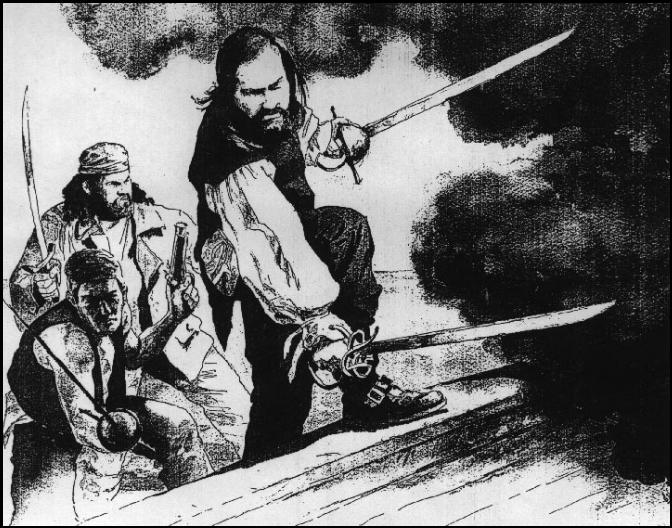
PIRATES! GOLD – RULES OF PLAY
WELCOME TO PIRATES! GOLD
The stars of new Kings and Emperors are rising in Europe. New opportunities abound for the ambitious man. There are reputations to be made, fortunes to be won, beautiful women to wed, and with royal favor, you may even gain a patent of nobility! “Duke of the Realm” has a fine sound to it, does it not? These are days when glory and fame can come from a humble beginning.
Nowhere are the opportunities greater than in the Spanish Main — the Caribbean Sea — the crossroads of the Atlantic. Here, the Great Powers engage in an unending struggle for dominance of these strategic waters. Here, the displaced of the Old World seek to wrest a living from the New. Here, the
seas are filled with rich merchantmen, ungainly cargo fluytes, and — the greatest prize of all — Spanish galleons, slow and fat, heavily-laden with Spanish gold!
TO BEGIN
To begin your adventure, load your game according to the instructions in the Captain’s Broadsheet. While the game is loading, read the “Game Controls” section of the Broadsheet for instructions on how Pirates Gold! operates on your machine.
THE INSTRUCTIONS
THE CAPTAIN’S BROADSHEET
The Captain’s Broadsheet is a separate booklet contains loading instructions for Pirates! Gold. In addition, it describes how Pirates! Gold operates on your machine. It also contains play-hints, and answers to commonly asked questions about this game.
THIS MANUAL
This manual is divided into four sections:
Book I provides comprehensive information on how to play, as well as some historical background.
Book II provides more details on the various events which take place during a voyage. It also discusses your goals and the treasures awaiting a heroic and lucky Captain in the Caribbean.
Book III provides specific details on the ships of the period, the famous pirate expeditions, and the political and economic situation in each of the six eras.
The City Gazetteer lists and describes the cities of Pirates! Gold.
2
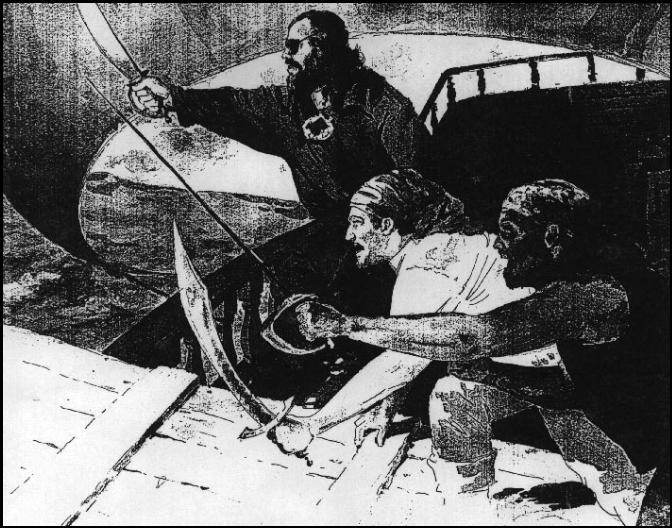
BOOK I: INSTRUCTIONS TO CAPTAINS
3
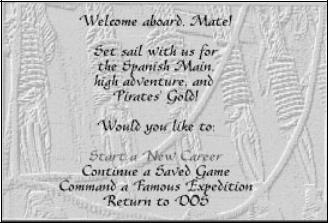
A WORD ABOUT YOUR GOALS
From humble beginnings, you are seeking to make your fortune in the West Indies. Eventually, you hope to retire to a life of wealth, ease, and high status. When you retire, your status is determined by your personal fortune, your rank, your lands, your reputation, the wife you marry (if any), and whatever especially pleasing events befall you during the course of your adventures.
You can retire — and end the game — at a bank in a city after you divide up the plunder from the current voyage. At this point you’ll learn how well you did in the game. If you are dissatisfied with your success and your health permits, you can leave retirement and take up adventuring again. As you play, you may wish to make a few “trial retirements” to see how this works. See “Book II” for more information on retirement.
THE MAIN MENU
To begin playing Pirates! Gold, install and run the game according to the instructions in theCaptain’s Broadsheet. If all is well, you’ll see a number of opening screens. These will be followed by the “Main Menu” screen which contains the following options: “Start a New Career,” “Continue a Saved Game,” “Command a Famous Expedition” and ”Return to DOS“.These options are described below.
START A NEW CAREER
This begins a complete adventure, from your arrival in the New World to your well-earned retirement. This is the “standard” game, and can continue for quite some time.
When you first play Pirates! Gold, you should start a new career.
CONTINUE A SAVED GAME
This option allows you to resume any game in progress. See the Captain’s Broadsheet for instructions on how to load and save games.
COMMAND A FAMOUS EXPEDITION
A famous expedition is a “short game” where you command just one expedition. In a famous expedition you often start large, with many men and ships under your command; however, the expedition ends when you divide the plunder.
Each expedition recreates the exploits of a famous — or infamous — historical pirate. They are not for the novice or the faint of heart: doing as well as the historical model can be a very challenging task indeed! Don’t choose this option for your first few games; instead, you should start a new career.
The famous expeditions and the events upon which they are based are described in the “Famous Expeditions” section of this manual.
4

SELECTING AN HISTORICAL TIME PERIOD
After you have chosen a new career on the Main Menu, a new menu appears. On the “Select an Historical Time Period” menu, you choose when your pirate’s career will begin. (For your first game, choose “The Buccaneer Heroes — 1660.”)
The historical time period has a large effect upon the game. The Caribbean and the Spanish Main were a changing environment. As military and economic power waxed and waned, new colonies appeared and old cities declined. The region gradually changed from total Spanish dominion in the 1560s to a wild frontier for European colonization in the early 1600s, and, by the arrival of the 18th Century, to a cosmopolitan nexus in a global economy.
This menu appears only when you begin a new career. It doesn’t appear when you play a famous expedition; in an expedition, the time period is already set. When you continue a saved game, you have already chosen the time period.
Each of these historical periods is described briefly below; for more detailed descriptions, see the section “The Historical Periods.”
THE SILVER EMPIRE — 1560
This is the earliest period in the game. In this era, the Spanish Empire is at its peak. All the colonies in the Caribbean — with one lone exception — are Spanish. All the major ports and trade are controlled by Spain. However, Spain’s profit has been so great that other Europeans are attracted to steal and plunder whatever Spain cannot protect.
Because of Spain’s great power, this is an extremely challenging era, and should not be attempted by novices.
MERCHANTS AND SMUGGLERS — 1600
This era is very similar to “The Silver Empire,” but Spain is slightly weaker. A few abortive non-Spanish colonial ventures have begun, but the Caribbean remains essentially Spanish. Another change is the predominance of the Dutch smuggling trade.
Like the 1560s, this era is extremely challenging and should not be attempted by novices.
THE NEW COLONISTS — 1620
This era sees the first successful colonies founded by the enemies of Spain, while Spanish power continues to decline. With these colonies, prospects for piracy and privateering are improved.
Life is fairly challenging for would-be pirates and privateers.
WAR FOR PROFIT — 1640
This era is the heyday for small, independent buccaneers. The Spanish military and economy are at their nadir, while new European colonies are blooming throughout the Antilles.
This period is a Golden Age — literally! — for the independent and resourceful sailor. It is an enjoyable era for players of all skills.
THE BUCCANEER HEROES — 1660
These decades are the peak of swashbuckling adventure in the Caribbean. Spanish wealth is reappearing, but their military power remains a joke. European colonies and ports abound, fortunehunting sailors crowd the taverns, searching for lucky Captains.
This classic age makes piracy a pleasure for players of every skill level. It is the suggested level for your first games of Pirates! Gold.
PIRATES’ SUNSET — 1680
This era is the last for Caribbean pirate adventuring. European nations now take seriously events in the Caribbee. Navy warships are on patrol, Letters of Marque are harder to find, governors are less tolerant. Enjoy this era while you can, for it is the end of an age.
This period is somewhat tougher than the previous eras. It may be a bit too difficult for novices, but other players will find it quite interesting and challenging.
5
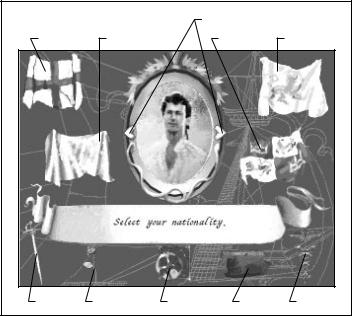
CREATING YOUR CHARACTER
After you select a historical period for your game, you then create your character, deciding upon name, nationality and special proficiency. In addition, you must set the difficulty of the game itself.
CHOOSING YOUR NATIONALITY
In most scenarios, you can choose one of four nationalities: English, French, Dutch, and Spanish. The choice of nationality has important effects upon play: where you start, what ship(s) you have, the size of your crew, your initial wealth and reputation, and so forth.
Your nationality also helps determine your relations with the various cities of the Spanish Main — if you are English, for instance, and England goes to war with Spain, Spanish towns will tend to be wary of you.
However, your actions during your career speak louder than your nationality: if you please a nation, a governor may reward you. If you anger a governor — even a governor of your own nationality — he may order his harbor forts to fire on you!
Finally, note that your nationality does not require you to support that nation during your career — many of France’s admirals during the 1680s were Dutch buccaneers!
SPECIAL SCENARIO NOTES
The Dutch nationality is not available in 1560. At that time, the Dutch were still a part of the Spanish Empire.
Your nationality is pre-chosen when you play an historical scenario. That is, if you play the “Battle of San Juan de Ulua,” you will be English, like the actual historical figure, John Hawkins.
NATIONALITIES
English
English is often a useful nationality. This nation supports privateers in the 16th Century, and is just as generous in the 17th.
There are few friendly bases for you in early scenarios, but in later scenarios England has a number of fine ports, particularly Port Royale in Jamaica and St. Kitts in the Caribbee Islands (Lesser Antilles).
French
French is the classic nationality for pirates. Although this nation provides less support to its sons overseas, it also gives them more independence, more freedom of action.
France has a number of tiny settlements on Florida and in the Bahamas in early scenarios; during middle and later scenarios, cities on west Hispaniola and Tortuga are ideal pirate bases.
Dutch
This is an exciting and different nationality. Except in the 1620s, the Dutch sailed as traders to the Caribbean, not as warriors. Of course, once in the Caribbean, more than a few supplemented their earnings in legitimate activities with more violent and profitable pursuits. As a rule, Dutch traders tried to stay on the good side of England and France, although this was not always possible.
Character Creation Screen |
Difficulty Level |
|
||
English Flag |
French Flag |
|
Spanish Flag |
Dutch Flag |
Fencing |
Wit & Charm |
Navigation |
Gunnery |
Medicine |
6
You cannot choose Dutch as your nationality in the 1560s. In other early periods, the city of Curacao, off the coast of South America, is a major Dutch port. In later scenarios, the Dutch have possessions scattered across the islands of the Caribbean; St. Martin and St. Eustatius, two particularly wealthy cities, lie on the northern boundary of the Lesser Antilles.
Spanish
This is the most difficult nationality to play. As a Spanish renegade, you start in a weak position, although in 1680 you can play the interesting role of a Costa Guarda — the Spanish Caribbean coast guard who often acted like pirates themselves!
YOUR NAME
Use any name you wish.
SPECIAL ABILITIES
This choice determines your special skill. This doesn’t much matter in Apprentice level, where all tasks are rather easy; however, at the higher levels, you will want to be proficient in the area which gives you the most trouble.
Fencing
You are well trained and have great reflexes, making your opponents seem slow and unskilled by comparison.
Navigation
Your fine grasp of sea and sail makes your ship travel smoothly and rapidly across the often-treacherous Caribbean.
Gunnery
You are highly-skilled with a cannon, and you’ve passed some of that skill onto your crew. Your ship’s broadsides are more likely to hit their target.
Wit and Charm
Your dashing good looks and smooth tongue make you quite popular with the townsmen (and women!).
Medicine
You are trained in the latest techniques in the healing arts — leeches, cupping, branding, and the like. You are thus likely to remain healthy longer, and to suffer less from injuries. As a result, your career as an active pirate can last longer.
DIFFICULTY LEVEL
There are four difficulty levels in Pirates! Gold: Apprentice (the easiest), Journeyman, Adventurer, and Swashbuckler (the hardest). For your first game, choose Apprentice.
The difficulty level you choose determines the difficulty of each major aspect of play. At lower levels, your fencing opponents will be weaker and easier to defeat; cities will be less likely to fire on your ships when they enter the harbor; your men will need less treasure to be happy; the weather will be milder; and so on. On the other hand, your share of any plunder gained will be smaller. To gain the greatest success possible in Pirates! Gold, you need to attempt the more difficult levels.
Apprentice
At this level, you get the most aid from subordinate officers on the ship: they’ll tell you whose waters you are sailing in, keep you posted on your crew’s morale, and so forth. This makes play easier, but whenever you divide the loot, all those experts take rather large shares, leaving little for you.
Journeyman
This level is moderately easy. Your subordinates are less expert (but still good), but your share of the plunder is larger.
Adventurer
The adventurer level is moderately difficult. Weather begins to be a large concern, and your opponents become quite deadly with the blade. Your subordinates are mediocre, but your share of the booty is quite large.
Swashbuckler
This level is difficult. The weather is extremely realistic (and quite often terrible), your enemies are powerful and universally hostile, your crew is unruly, and your officers are wretched scum. On the bright side, if you do survive, your share of the loot is the largest possible.
YOUR STARTING TALE
Once you have finished creating your pirate, the scene changes to an important event in your early life, and you’ll learn how you came to join the “Brotherhood of the Sea.” Then you face your first opponent in single combat. When he is defeated, you are on your way to adventure on the High Seas!
7
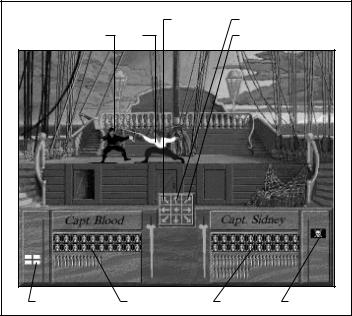
FENCING AND SWORDPLAY
In the 16th and 17th Centuries, the world was a violent and dangerous place. The European man met that violence with his blade. You discouraged thieves, righted injustice, protected your family, and maintained your honor with a sword. Whether challenged to a duel, or fighting your way through a tavern brawl, skill with cold steel was simple survival.
CONTROLLING YOUR PIRATE
The Captain’s Broadsheet describes how to control your pirate and his weapon.
CHOOSING YOUR WEAPON
In battle, you have three different weapons available: rapier, cutlass or longsword. Each has its own strengths and weaknesses. As you play Pirates! Gold, you’ll learn which blade suits your particular level of skill and style of swordsmanship.
The Rapier
The rapier is a long, thin, flexible weapon with a sharp point but no real edge. It can be maneuvered easily, and thrust into a target with accuracy. It has a longer reach than any other
Fencing Screen |
Attack Lines |
Parry Lines |
|
Your Opponent |
You |
Parry and Retreat Lines |
|
Opponent's Moral |
Opponent's Men |
Your Men |
Your Moral |
8 |
|
|
|
weapon, but its strikes do the least damage. The rapier is a gentleman’s weapon.
The Cutlass
The cutlass is a heavy, curved cleaver with a sharp edge but short reach. When it hits, a cutlass does far more damage than a rapier. Cutlasses are popular with buccaneers, cutthroats, and other untutored fighters. They are mean weapons.
The Longsword
The longsword is a classic weapon of medium length — shorter than a rapier, longer than a cutlass. It has a heavy blade, and its blows do more damage than a rapier. The longsword is a fine weapon for a soldier.
THE PRINCIPLES OF FENCING
Combinations
Like all active men of your time, you are a trained swordsman. Attacking and defensive movements, including wrist, arm, body, and footwork are as automatic as throwing or kicking a ball. Put together, these motions form “combinations” that allow you to attack, defend, or retreat in various ways.
In combat, victory depends on selecting the best combination. If you recognize an attacking combination fast enough, you can block it with a defensive combination, or counterattack with a combination which exploits your opponent’s attack.
The attacking combinations are thrust and slash; the defensive combinations are called parries. Any combination can be carried out low, medium, or high: that is, you can thrust high, parry medium, slash low, and so forth.
Hits
You hit your opponent when he fails to successfully parry your attacking combination. Each hit weakens your opponent. If you are leading your men in combat against a group of opponents, each of your hits also lowers the morale of the opposing force (the enemy is dismayed to see you strike their leader!).
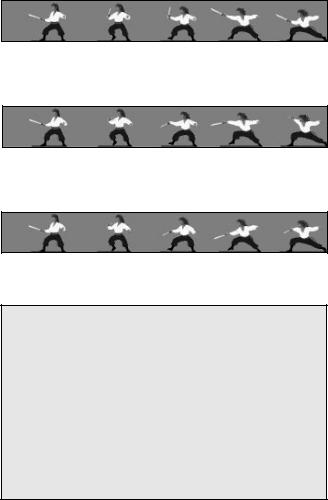
Conversely, when your opponent hits you, you are weakened and your men demoralized.
Retreat
Retreat is easy. Simply move off the edge of the screen. Of course, you lose whatever you were fighting over and your reputation suffers. On the other hand, retreat is usually preferable to surrender...
Surrender
Surrender occurs when one fighter is being badly beaten by the other. Over the course of the battle, the losing fighter’s morale, represented by the flags on the screen, declines as the winning fighter’s morale improves. When a fighter’s morale gets too low, any blow may force him to surrender.
In massed combat, each man’s morale is deeply affected by how his side is doing. If your force is taking terrible losses, your morale will fall. On the other hand, if your men are beating the enemy, your opponent’s morale will crumble.
In any case, the side with more men has a significant advantage. When your enemy outnumbers you greatly, you had better seek to defeat their captain quickly before sheer weight of numbers gives him the victory.
ATTACKS
As described above, each combination is a different swordfighting maneuver. During battle, you select a combination and your body automatically makes the moves. Each combination takes a different amount of time to execute; each does a different amount of damage.
There are two types of attack: thrust and slash.
During a battle it is important to mix up your attacks: if you continuously thrust high, for example, your opponent will learn and take advantage of your predictability, perhaps by parrying your attack and then launching a quicker counterattack before you can respond!
The Slash
The slash is a brutal, heavy blow, with damage done by the edge of the blade rather than the point. Since you’re using the edge of your weapon, you must be closer to your opponent to hit him. On the other hand, a successful slash can do an enormous amount of damage as you draw your entire blade-edge across your enemy’s body.
Slashing High: This takes the longest time to execute, but has an extra-long reach. If it succeeds, this combination does twice the normal amount of damage
Slashing Mid-Level: This is a faster slash than the high slash, but it is still slower than the thrust. This combination does twice the damage of a normal attack.
Slashing Low: This is the fastest slash, but has a shorter reach. This combination too does twice the damage of a thrust.
THE COMMON MAN AS WARRIOR
In this turbulent time, there are more clergymen than sheriffs! A man protects his own property and person against thieves and banditry — if he doesn’t, the kings and governors surely won’t! It is the rare man who goes without some kind of weapon.
Noblemen settle disputes quietly in duels, rather than through open warfare (a barbaric practice, frowned upon by the Crown, for its detrimental affects upon the important business of trade and taxation).
Unable to afford the high-quality blades of their “betters,” commoners must be satisfied with staves, clubs, crude spears, large knives and such homemade implements of carnage. When they can get a weapon, the common-folk prefer the heavy cutlass, an ideal weapon for a stout but untutored fighter.
9
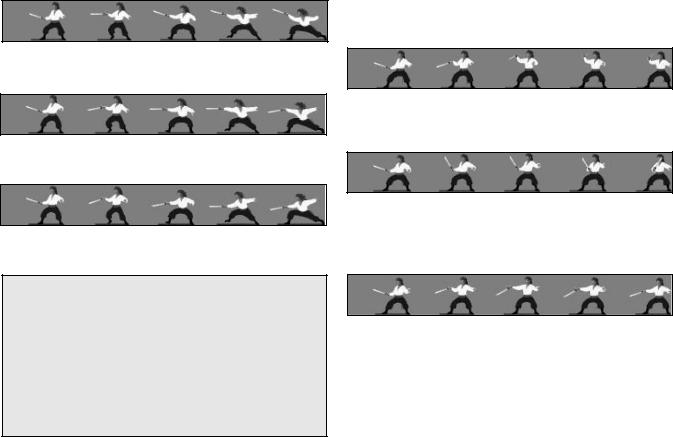
THE THRUST
When you thrust, you are attacking your enemy with the point of your blade rather than the edge. These attacks are faster than slashes and typically have longer reach. On the other hand, they do half the damage of a slash.
Thrusting High: This is a moderately fast attack with a longer reach than lowor mid-level thrusts and slashes.
Thrusting Mid-Level: This is the second-fastest attack, with a medium reach.
Thrusting Low: This is the fastest attack in the game, but it has a short reach.
THE COLONIAL FRONTIER
The colonial frontier is even more unruly than in the homeland. This is especially true of the English and French colonies, largely populated by convicts, fortune hunters, deadbeats, religious fanatics, and other people the homeland was happy to ship across the seas.
Furthermore, in the colonies the landowner might be absent or nonexistent. In Europe, every square inch of the land is part of some nobleman’s holdings, and he and his family usually live right up the road, ready to enforce ancient feudal custom and law. In the colonies, the strongest rule by the blade.
THE DEFENSE
In fencing, the defense is faster than the attack. The fencer doesn’t have to extend his arm or body at all; he merely has to move his wrist to bring his sword into line to block the enemy’s attack.
Still, nobody ever won a battle by parrying; to beat your opponent, you’ll have to go on the offensive some time. The best fighter mixes parries with attacks.
Parrying High: This position counters high thrusts and slashes. As high attacks are slow to develop, defensive fighters rarely stand “on guard” in a high parry.
Parrying Mid-Level: This position counters any mid-level attack or slash. This is the classic “on guard” position to which many swordsmen return. A fencer can move from this position to any other position very quickly.
Parrying Low: This counters any low combination. Experienced swordsmen periodically stand “on guard” in a low parry, since low attacks can develop very quickly.
10

PARRYING AND RETREATING
You can parry while retreating. These maneuvers offer the same protection as the normal parry; they also allow you to leave the battle without getting stabbed in the back!
Parry High and Retreat: This is the same maneuver as Parry High, except that you backpedal while parrying.
Parry Mid-Level and Retreat: This is the same maneuver as Parry Mid-Level, except that you backpedal while parrying.
Parry Low and Retreat: This is the same maneuver as Parry Low, except that you backpedal while parrying.
LEADERSHIP IN BATTLE
Only a few of your battles are man-to-man duels. Most of the time you are leading your stalwart crew against the enemy. As you duel the enemy leader, your crewmen are also fighting his men.
Morale
Your hits against the enemy leader, and his hits against you, change the morale of each side in battle. As your morale improves, his declines, and vice versa.
Your side’s morale is very important to your duel and to the general melee: if your morale is low, any hit might cause you to surrender; if your morale is high, your men will do far more damage to the enemy.
Number of Men
As you fight, your men and the enemy force will suffer casualties. The rate each side suffers casualties depends on their number and their morale. If morale is fairly equal, a force with superior numbers will inflict more casualties. However, an inferior force with high morale can avoid casualties and inflict serious losses on a larger force with very low morale. In the long run, morale can be more important than numerical comparisons.
Retreat and Surrender
You can lead your men into retreat from a battle by retreating yourself. Surrender occurs when you inflict enough hits on an enemy with very low morale or a vastly inferior force. When your opponent is down to one man, any successful hit will make him surrender, regardless of morale. Of course, the same could happen to you.
FIREARMS
Firearms exist in this era, but they’re newfangled weapons, of slow speed and dubious reliability. Throughout the 1500s firearms are fired with slow match. Reloading is a long, laborious process that requires two minutes or more and is complicated by the need to handle loose gunpowder while holding a lit match!
A better gun, the flintlock, is invented in 1615. It is mainly used by hunters, sportsmen and buccaneers through the 1630s. However, it is still too unreliable to carry into battle until the ‘70s. In a fight you might carry a loaded pistol or three, but you still put most of your faith in your trusty blade, which can’t jam or misfire, and which still works if you get it wet.
In Dumas’ Three Musketeers, set in the 1620s, the title characters are members of the most elite firearms unit in the entire French army. Still, they rely far more on their swords than their guns...
11

IN THE CITY
In the 16th and 17th Centuries, Europeans have a precarious toehold on the New World. The vast majority of North and South America and the Caribbean is unexplored and unconquered.
The new land isn’t kind, either. Hostile Indians still control most of the territory, and they have no love for the rapacious, murdering white men who enslave them, steal their gold, and destroy their great civilizations. The weather of the New World, from the frigid cold of the North to the killing heat of the South, is treacherous. Huge swathes of pestilential jungles and swamps lie filled with diseases for which the Europeans have no defense.
In these turbulent times, Europeans venture forth from their cities at great peril.
CITY STATUS
Over the course of the 16th and 17th Centuries, cities grew, flourished, and declined across the Caribbean. The cities in Pirates! Gold change dramatically from period to period. Therefore each period offers different strategic challenges.
Cities in Pirates! Gold vary in size, defensive strength, economic strength, and political affiliation. Over the course of the game, a city may grow larger or smaller, richer or poorer, weaker or stronger. Cities are attacked by Indians, weakened by disease, and captured by warring nations. Occasionally, a city is sacked by bloodthirsty pirates.
Your reception in a city depends on the city’s present status. One city may fire upon your ships when they arrive, another might welcome you with open arms — a wise pirate will quickly learn the difference.
THE CITY GAZETTE
If you know a city’s status, it is recorded in the city gazette in your cabin (see “The Map of the Caribbean” in the section “The Captain’s Cabin”); if your information on a city is out of date, your gazette is blank.
CITY NAME
A city’s name may differ from one historical time period to the next. A city might have been captured by another power which changed its name; alternatively, an older city might have vanished completely and a new city established nearby.
Take for an extreme example the island which is today known as Santa Catalina, off of the coast of Honduras. In the early 1600s the English started a colony named “Providence” on this island. This colony was later captured by the Spanish, who renamed the colony “Santa Catalina.” Shortly thereafter, the colony failed altogether. Thus, in the 1620 scenario of Pirates! Gold, there is an English city named Providence on the island. In 1640, the city is owned by Spain and is named Santa Catalina. In later scenarios, there is no city on the island at all.
12
NATIONALITY
A city may change its allegiance during a scenario. This typically occurs when enemy soldiers capture the city, but you may also have an opportunity to change a city’s nationality after you plunder it.
This doesn’t occur every time you plunder a city: you must have a sizable crew under your command. The smaller the city’s population and the larger your force, the greater the chance of causing the city to change its flag.
Capturing an enemy city for your country is highly popular with your king...
ECONOMIC STATUS
A city may be rich, poor or in-between. The city’s economic status determines how many goods the merchant has to sell, their price, and whether the city will trade with you at all (see “Spanish Trade Restrictions,” below).
Your actions can affect a town’s economic status over the course of a scenario. If you plunder a town or engage in piracy outside its harbor, it becomes less prosperous. On the other hand, if you trade regularly in a town, it becomes wealthier.
Struggling
Struggling towns are in economic difficulty. They trade with almost anyone. Prices of goods are low, as are the quantities available.
Surviving
These towns have either small or depressed economies. Surviving Spanish towns trade with foreigners whose local reputation is fairly decent. Prices and quantities are usually modest.
Prosperous
Prosperous towns have large, strong economies. Prosperous Spanish towns will trade with you only if you are a Captain of high repute. Prices of goods are fairly high, and goods are available in reasonable quantity.
Wealthy
Wealthy towns are at the peak of the economic spectrum. With very few exceptions, only old, rich Spanish towns reach this status; these towns almost always follow the letter of the law. Only the very best and most reputable Captains of any nationality are allowed to trade in these towns. Prices are high and goods are plentiful.
Spanish Trade Restictions
In Spanish towns it is illegal to trade with anyone other than Spanish merchants who sailed from Seville and are properly accredited by the Spanish government. However, local governors and merchants often ignored this tiresome legality, especially if the economy is suffering. As a result, traders in towns sometimes ignore what the national government says and instead develop their own opinions, based on your reputation in that area.
FORTS
At constant risk from Indians, enemy powers and brigands, many cities in the Caribbean are surrounded by a variety of defensive works. These range from wooden stockades to extensive stone walls rivaling the great city-fortresses of Europe.
In Pirates! Gold, there are many levels of fortifications, indicated by the number of forts. The higher the level, the stronger the city’s defenses.
SOLDIERS
The wealthier and larger a city, the more soldiers it has defending it: rich cities may have hundreds of soldiers, while poor cities may have none. When you attack a city from the sea, the city’s soldiers operate its cannon; when you attack from the land, they sally forth to meet you outside the city walls. When you finally storm the fort itself, you fight the soldiers’ captain, while your crew battle the remaining soldiers.
Needless to say, it is best to outnumber a city’s soldiers when you attack it. You can beat a city’s soldiers with a smaller force, but it’s not easy. (see the section “Leadership in Battle” in “Fencing and Swordplay”).
CITIZENS
A city’s population rises and falls with the years. It may grow with a new influx of colonists from the homeland; it may decline as the result of Indian attack.
The more you trade with a city, the larger it will grow. This is useful because a city with fewer than 600 citizens isn’t important enough to have a governor. The more friendly governors you know, the more opportunities you have to get special assignments, meet their lovely daughters, and receive land grants and promotions.
13
GOLD
Besides gaining your country’s gratitude when you capture an enemy city, you also get some of the city’s wealth. The actual amount varies with the length of the battle. Longer fights give the citizens more time to hide their wealth. Thus, a head-on assault might be bloodier than a long battle of feint and maneuver, but it will also be more profitable.
KEEPING TRACK OF THE CITIES OF THE CARIBBEAN
All other things being equal, cities slowly prosper and grow, gaining economic strength, which attracts population, who in turn hoard wealth, which obliges the government to install troops and forts to protect this wealth. Traders and smugglers help this economic growth with their buying, selling, and transport of goods. Pirates, buccaneers and privateers taking ships from waters near the colony will hurt its economic growth.
There is no profit in attacking a poor city and it’s dangerous to attack a strong one. But, without spending long, tedious and dangerous weeks visiting each city on the map, how are you to know which is which? If you keep your ears open, you can get a pretty good idea of the status of even far-off cities.
There are three ways to learn about cities:
Purchase Intelligence From Shady Characters in the Tavern
Taverns are filled with merchants and sailors who regularly travel the cities of the Spanish Main. One of these travelers may offer to sell you information on a city he recently visited. If you meet his price, he provides you with the city’s current status. This data is always correct at the time it is sold to you, though subsequent events may shortly render it obsolete.
Listen to Tavern Gossip/Ask Passing Ships for News
Though you won’t get a city’s actual status this way, you can learn about recent events in the Caribbean — Indian attacks, gold mine discoveries, and the like, which have important effects on cities.
Indian Attacks: Indian attacks deplete a city’s soldiers, but leave the population and economy intact. Such cities are ripe for attack.
Pirate Raids: Pirates steal from a town whatever gold they can find. These raids also damage a town’s economy. There’s little profit in attacking a city which another pirate has already plundered...
Diseases: Malaria and other diseases reduce the troop garrison of a city and its population. Disease can also slow or stop the city’s economic growth.
Gold Mines: These cause a one-time upswing in the city’s economy and dramatically increase the city’s disposable wealth (ie, its gold). These finds are usually small, perhaps just a shortlived alluvial wash in a nearby stream or river, but they invariably generate a ”gold rush“ mentality in the town. These cities are good to plunder. In addition, the price of everything will be high, so they’re also fine places to sell goods.
New Governor: If a new governor is installed in a city, he doesn’t necessarily have the same attitude toward you as his predecessor. You won’t know the new governor’s attitude until you visit him.
14
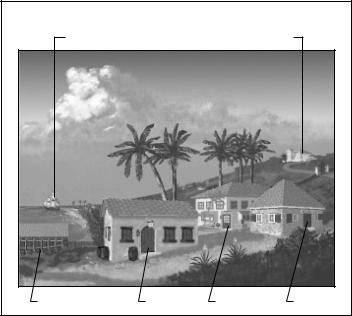
THINGS TO DO AND SEE IN TOWN
The City Screen |
|
|
|
Leave the Town |
|
The Governor's House |
|
The Shipwright |
The Tavern |
The Merchant |
The Bank |
THE GOVERNOR
Towns with a population greater than 600 citizens have a governor. His residence, the mansion on the hill, is the seat of government and the center of news and intrigue for the colony.
A visit to the governor may be useful. He can tell you with whom his nation wars and allies. He may make special offers or rewards. With luck and sufficient prestige, you may meet his niece or even daughter. However, the governor hasn’t much time to waste entertaining coarse seadogs like you; once you have visited the governor of a town, don’t expect to gain admittance again soon.
Towns with fewer than 600 citizens don’t have governors: the mansion on the hill lies empty and vacant.
YOUR RELATIONS WITH THE GOVERNOR
A governor’s attitude toward you begins with the “official” attitude of his nation toward your activities. However, any particular favors you have done for him are remembered, as well as any especially nasty things you have done to his city (such as plundering it!).
You can curry favor with a governor by capturing a pirate in waters near his port and then returning the pirate to him for punishment. Conversely, a governor is dismayed if you capture his nation’s ships in local waters, and is especially unhappy if you have plundered his town.
When a governor is hostile to you, he will order any harbor forts to fire upon your vessels as they sail in. In general, if the governor’s nation is hostile toward you the forts usually fire. If the nation is wary, the governor’s personal attitude and the size of your force are the crucial factors.
TALKING WITH THE GOVERNOR
Political Situation
The governor may discuss the current political and military situation with you, telling you whom his nation is allied with and whom it is at war with. This is valuable information: on future visits he may reward you if you have attacked enemy ships and towns.
Be warned, however, that the political situation in the Caribbean is volatile, to say the least. Nations switch alliances with appalling frequency: a country‘s enemy one day may be its firm ally the next. Don‘t expect to get rewarded for attacking a country‘s new ally, even if they were bitter enemies when you did it!
15
